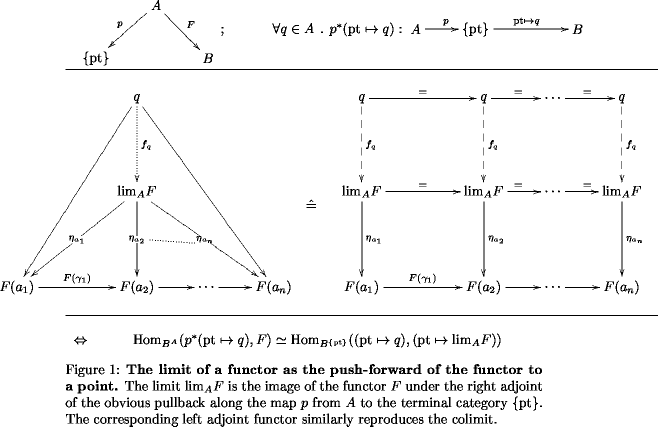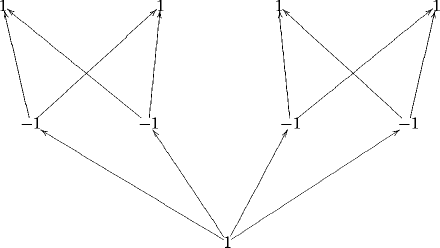For the record and for my own benefit, I’ll review and summarize some of the enriched category theory aspects appearing in the above discussion (many thanks to Robin Houston for the help he provided!!), and pointing out where it says what in Kelly’s book:
G. M. Kelly, Basic concepts of enriched category theory
There are several directions from which to approach the generalization of ordinary (co)limits known as indexed (co)limits and as (co)ends. I’ll do it in a fashion somewhat reverse to how Kelly presents it:
For me the starting point is the observation (section 3.4) that a cone over a functor
with tip usually thought of as a a transformation from the constant functor with value the tip into the functor G
where
can equivalently be thought of as a cone in “copresheaves” on , with tip the constant functor at the singleton set:
I suppose one way to motivate indexed limits is to observe that in the formulation on the right hand, as opposed to the one on the left hand, there is a singled out functor appearing, namely
Therefore it is natural to generalize the notion as it appears on the right, by replacing this constant functor with something else.
And indeed, that’s what one does:
we allow to be replaced by any other enriching category (I won’t try to list all the properties we need on to make each an all of the following constructions possible) and generalize
first to
and then to
where now
can by any functor, not necessarily one constant at the tensor unit object.
(Now I am on p. 37, equation (3.1).)
Instead of saying then that the cone is indexed by , we say that it is indexed by (which includes the information about ’s domain , of course).
Now, a limit of a functor is something that represents the universal cone over , in that morphisms into the limit are in bijection with cones over the functor.
So we do the same here and define the limit of indexed by , what you might denote , by the property
naturally for all .
Only that, for some reason, one invents completely unsuggestive new notation and writes for what I called above. So this should really read:
For indexed colimits the discussion is the same with both (!) and replaced by their opposite categories. (equation 3.5, p. 38).
The -indexed colimit over also receives its own notation: :
A most important special case of such indexed (co)limits is that where we can think of them as weighted (co)limits, a situation which is the basis for a striking similarity between indexed colimits and the theory of ordinary integration (as in functional analysis).
That special case is that where the codomain of our functor is (co)tensored over the enriching category. (section 3.7, p. 48)
A -category being tensored over is much like a “-module”: behaves like a monoid which acts on . Or more suggestively, behaves like a vector space over .
(Here is a question: is there a difference between saying that is tensored over and looking at as a monoid in -Cat and at as a module for that monoid in -Cat?)
If is tensored over one writes (this time the notation is natural)
for the result of acting with on .
(The notation for the cotensor product, on the other hand, I can’t even typeset here without looking up special character tables…)
The punchline now is that if is tensored over , the -indexed colimit over a functor can be expressed by a coend over the tensor product:
(equation 3.70, p. 53)
So now I say what what a coend is, the thing appearing on the right hand here:
Where indexed (co)limits generalized ordinary (co)limits by generalizing what we may regard as the tip of a cone, (co)ends generalize ordinary (co)limits by generalizing what the functor we take the limit over may be: namely from the case of functors on to functors on .
One way to motivate this is by thinking about what natural transformations really are:
given two ordinary functor:
a natural transformation is, for each a map
namely a morphism in , such that all naturality squares commute, which in terms of this map means that for all in we have
The point to notice is that in the special case that the functor is trivial this reduces precisely to a cone over the functor . So the naturality of natural transformations is a generalization of the notion of cone to functors with a covariant and a contravariant dependence on their domain category.
As the vertical morphisms of a cone form a natural family of morphisms with respect to the functor that the cone lives over, the morphisms of a natural transformation form what is called an extraordinary natural family (1.7, p. 17).
Generally, then, this is the definition of an end: not just a universal natural family of morphisms (that would be a limit), but a universal extraordinary natural family.
More precisely for a functor
a (extraordinary) natural family of morphisms from some object
for all is one for which for all
in we have:
Or rather, this is the condition when it makes sense to speak of morphism in , as when . More generally one reformulates this into a more robust (but less enlightning on first sight) way which works for all enrichment categories. See equation 1.40 on p. 18.
Then (p. 27) the end
over a functor is the (domain object of the) universal such natural family, in that every other one factors through it.
We get from this back to the motivating example of natural transformations by now noticing that this gives a way to speak of the -object of natural transformations in any enriched context (2.2, p. 29): the -object of natural transformations of -functors is defined by the end over the functor
Finally, now, we get to coends, by dualizing ends: the coend is defined by (3.67, p. 53)
naturally for all .
Just as ends over reduce to limits when there is no dependency of on the first (contravariant) variable of , coends reduce to colimits in the same case.
To get an intuition for what is going on with our formula for the -indexed colimit over
it is helpful to consider the special simple case that John described here:
suppose that such that isomorphism classes in are given by natural numbers and such that coproduct induced addition of these natural numbers.
Let be the discrete -category over a set : all Hom-objects are trivial.
Moreover, let , the category whose objects are categories with a -action on them and whose morphisms are -linear functors between these.
(I am hoping that I am right that this is -tensored. If not, just take instead in the following.)
Then a functor
i.e
is like a vector-valued function on the set , and a functor
is like a number-valued function on . And
is like a vector valued function on obained by multiplying pointwise by .
Moreover, the coend
reduces to just to coproduct
This is just like the integral of over weighted by .
It is amazing how close the notion of coends, and also the notation used, is to ordinary integration theory. But the notation is not perfect. First of all it is a pity that the coend has the integration bounds on top instead of at the bottom of the integral sign. It should be the other way around.
If I had to make up notation from scratch, I’d opt for writing the coend of a functor with values in a -tensored category with weight as
Moreover, if products and coproducts coincide, such as in , I’d write (along the lines of John Baez, of course)
for , which would turn formulas such as 3.67 into pleasant familiar formulas such as


 .
. .
.
Re: Limits and Push-Forward
Isn’t that similar to zeta function regularization method? Every push forwared would be equivalent to a term of a Dirichlet series.